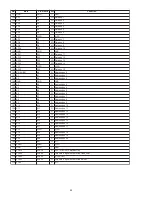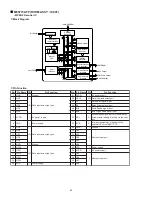
78
12.1.5 INTERFACE CONNECTOR
• Communication control
The protocol system is based on a system in which the computer
gives commands and the player returns statuses. The communication
protocol used conforms to that used by industrial and educational
equipment (changers, drives, LD players for educational use, etc.)
of our company, and supports Communication Mode 7 (CM 7).
CM 7 uses a method of proceeding a program by issuing each
execution command and confirming the execution status with a
request command.
First, the controller sends an execution command, and the player
returns the status of having received the command. Then, the
controller sends a request command, and the player returns the
corresponding status data. The controller repeats this operation until
it receives the status data required.
In CM 7, neither Completion of Execution Status nor error messages
are returned. Statuses returned in response to execution commands
are the End of Receive message <R> and Communication Errors
<E 00>. To confirm Completion of Execution or occurrence of
errors, use the request command “?J.” However, note that some
commands have restrictions or conditions, and that some commands
cannot be executed or may not be executed as they should be.
• Format
Serial control interface in conformance with the RS-232C Standards
• Connector
15-pin, D-sub connector
1
2
3
4
5
6
7
9
15
14
13
12
11
10
8
• Signal Line
No.
Name
I/O
Function
1
GND
−
Ground
2
TxD
O
Transmission output
3
RxD
I
Receiving input
4
DTR
O
Transmission permission
5
Reserved
−
6
Reserved
−
7
Reserved
−
8
Reserved
−
9
Reserved
−
10
Reserved
−
11
GND
−
Ground
12
Reserved
−
13
Reserved
−
14
Reserved
−
15
GND
−
Ground
• Specifications of Interface
Signal level
: RS-232C level
Data format
Data length : 8 bits
Stop bit
: 1 bit
Parity
: none
Transmission speed (baud rate):
Selectable between 9600 and 19200 bps, by exclusive command
of the player. Every time the power is turned on, the baud rate
is reset to 9600 bps.
Connection:
The computer and this unit are connected through three lines, as
shown below:
The player can receive commands any time as long as the power is
on. So, even when the RS-232C port of the computer is used,
connection of any control lines other than TxD and RxD is NOT
necessary.
However, some computers need physical CTS input for operation.
In this case, the DTR output, which always outputs positive electric
potential as long as transmission is possible, can be used. Connect
the DTR output to the CTS input of the computer as shown below:
Example of connection (connection with a DOS/V computer)
TxD
RxD
GND
RxD
TxD
GND
Computer
This Unit
TxD (2)
RxD (3)
GND (1)
This Unit (Player)
D-SUB 15P
Computer (DOS/V)
D-SUB 9P
DTR (4)
RxD (2)
TxD (3)
GND (5)
CTS (8)
Summary of Contents for VC-8100
Page 29: ...27 ...
Page 30: ...28 VQEB ASSY VWV1669 N 6 ch DNR VIDEO ENCODER C V Y 8 7 VQEB ASSY N ...
Page 39: ...37 R 8 12 232B ASSY DV F07 ONLY 232B ASSY VWG2201 R CN401 VKN1238 CN106 M2 4 ...
Page 40: ...38 FLKY ASSY VWG2192 S CN701 VKN1246 CN602 M2 4 8 13 FLKY KEYB and PS2B ASSYS S ...
Page 51: ...49 Q201 Q257 Q277 Q281 Q582 Q584 Q583 Q581 Q561 Q585 Q202 Q151 AVJB ASSY O VNP1725 B SIDE B O ...
Page 56: ...54 IC701 IC702 FLKY ASSY S VNP1778 A SIDE A CN903 P CN602 M S 9 8 FLKY KEYB and PS2B ASSYS ...
Page 57: ...55 IC1251 IC1201 KEYB ASSY T PS2B ASSY U VNP1778 A VNP1778 A U T ...
Page 58: ...56 KEYB ASSY T PS2B ASSY U VNP1778 A VNP1778 A U T ...
Page 59: ...57 Q701 Q702 FLKY ASSY S VNP1778 A SIDE B S ...
Page 67: ...65 ...
















































